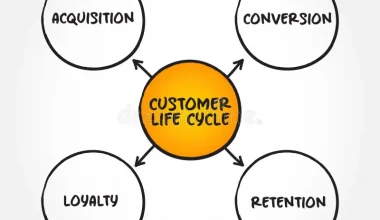In customer service, we are frequently on the reactive side of things. When you’re overloaded with support tickets, it’s difficult to be proactive and work on strategic steps to assist your clients to succeed in the long run. Furthermore, the same questions and difficulties will nearly always come back again and again.
A solid knowledge management system might be a game-changer if you actually want to help your clients flourish.
Creating a knowledge management system can assist you in lowering support costs, increasing customer happiness, improving the entire customer experience, and increasing customer success ROI. How? This thorough essay will assist you in developing, planning, and managing your knowledge management system. It will also include examples, types, advantages, disadvantages, advice, and software options for knowledge management systems.
Feel free to approach it as a choose-your-own-adventure book. So you can skip to the sections that are most relevant to your circumstances.
What is a Knowledge Management System (KMS)?
A knowledge management system is any type of information technology system that saves and retrieves knowledge to increase comprehension, collaboration, and process alignment. Knowledge management systems can be found within organizations or teams. They may also be utilized to centralize your knowledge base for users or consumers.
This is clearly a broad term, and rightly so.
This latter definition is what we’ll cover in this guide: how to create a knowledge management system, often known as a knowledge base, to improve the customer experience and assist customers in succeeding with your products or services.
While the term “knowledge management system” has a wide range of applications, it may be boiled down to the following goal: to assist people in better-utilizing knowledge to complete tasks. When viewed in this light, it is possible to redefine it as a more proactive kind of customer success. Instead of repeatedly addressing the same questions in your help ticketing system, you may answer clients’ questions in real-time as they struggle with their problems.
Types of Knowledge Management Systems
There are many different types of knowledge management systems, but they all have key traits in common. These are some examples:
- Content for FAQs
- Discussion board or community feature
- Tutorials and how-to articles
- Education, academies, and training programs are all available.
- Certificates
- Examples
- Webinars
Let’s take a look at some examples of well-executed knowledge management systems.
Examples of Knowledge Management Systems
#1. Tableau’s knowledge base is an example of a knowledge management system.
It has a search option that allows users to find answers to specific problems, as well as top articles and product-specific navigation. Furthermore, the sidebar contains a link to a Tableau community where users may bounce ideas off of others, as well as other customer education tools such as classroom training, e-learning, training videos, and webinars.
#2. R Studio is another example of a knowledge management system.
This one is more community-oriented, with the ability to submit and answer questions. It also contains articles that deal with common customer service difficulties.
It also includes, at the very bottom, what I believe are the most crucial links: learning materials and training. These can sometimes be the most valuable customer education elements for a technical product like R Studio.
Otherwise, here are a few firms to look into that have exceptionally effective knowledge management systems:
- Optimizely’s knowledge management base includes a variety of services such as an academy, a community forum, certificates, developer documentation, and more.
- SurveyMonkey’s knowledge base, which allows users to search by keyword or topic.
- Microsoft, whose information library is arranged into useful videos, training, and even product manager interviews
- Canva, whose knowledge base is exceptionally simple to use and search.
- Evernote, whose knowledge base contains not only useful materials but also clear instructions on how to contact the company.
- Google Analytics, which has its own predictive search engine, has a knowledge base.
Now that you understand what a knowledge management system is and what some examples are, let’s look at the major advantages of using one.
Advantages of a Knowledge Management System
The most significant advantage of knowledge management systems is that best practices are available to customers, resulting in satisfied and successful customers. Consumers that are happy and successful return to buy more (and more frequently) than other customers, and they tell their friends, becoming enthusiastic brand champions. Make no mistake: knowledge management solutions have real economic value.
We understand that client satisfaction fuels corporate success. Organizations that prioritize customer satisfaction are more likely to see revenue growth:
And, by offering a self-service customer service portal (i.e., a knowledge management system), you may increase customer assistance without increasing support costs.
It is relatively costly to have a customer service representative communicate with a customer for each and every issue. A discussion with a live customer care worker can cost $6–12 each engagement, whereas an automated conversation can cost as little as 25 cents, according to Forrester.
Developing a good knowledge management system can free up your support staff’s time while providing a comparable or even higher level of client satisfaction.
Knowledge management systems can also aid in the conversion of customers. Did you know that 32% of consumers seek product guides, educational information, and best practices when they require a new product, tool, or service? Your knowledge management system could mean the difference between a curious shopper and a decisive buyer.
Although we may think that a normal e-commerce site is very straightforward, individuals nonetheless visit the FAQ page with inquiries. It is nevertheless beneficial to amass knowledge in order to assist clients with their inquiries.
How to Create an Efficient Knowledge Management System
#1. Find the information and data you need for your type of knowledge management system.
Knowing what knowledge to document is the first step in establishing a knowledge management system.
What are the most prevalent challenges, difficulties, and questions that individuals have, and how can you chronicle the solutions to them?
Here are a few approaches for determining these variables.
- Examine your support ticket system. What are the most frequently asked questions? Is there anything, in particular, that is questioned again and again? These are the first questions you should strive to answer.
- Discuss with your team what challenges come up frequently. Gather your support team and have them offer ideas for knowledge management system articles to proactively answer queries that they receive regularly. Because these are likely to influence your support staff (it’s really frustrating to have recurrent issues), they should be prioritized right away.
- Use Google Analytics to find out what visitors are looking for on your website. If you’ve enabled the site search tool in Google Analytics, you can simply navigate to Behavior > Site Search > Search Terms to see what visitors are searching for. To see rising patterns over time, compare time periods and sort by “absolute change.”
- Use social listening and social tools to learn what your customers are saying about your business. Customers are more willing than ever to share their experiences with brands, according to 89 percent of customer service professionals, most commonly on social media, where more than 30 percent of individuals have gone to post about unfavorable encounters.
- When it comes to the overall consumer experience, there are numerous moving parts. Each role tends to possess a bit of knowledge about the overall experience. For example, salespeople’s feedback may differ from that of user experience researchers, customer support professionals, and marketers. (Frogbones)
It may also be beneficial to acquire some more qualitative insights in order to identify difficulties that may be in your blind zone. You can do this by conducting on-site or in-app surveys to find out what problems users are experiencing.
#2. Create an organizational structure for your knowledge management system.
The next question is, “How do you organize your system?” Here are some best practices for creating and managing your knowledge management system:
- Articles should be divided into a certain number of topic areas (try to stay within 4-6 categories).
- Identify the elements on the homepage that are most commonly used (e.g. the most popular articles and the search bar).
- Include regular links to other useful and related websites, videos, and training within your article material. (Internal linking can also enhance your site’s SEO.)
- Include a sidebar with connections to further resources such as chat, community, and courses.
- Include a feedback feature so that you can track how people react to your posts.
- Use a range of media, such as videos, photographs, text, and so on. Remember that everyone learns differently.
- Your knowledge management system’s structure will vary, but it should reflect your customers’ expectations to provide a fantastic customer experience.
- Your knowledge management system could include a frequently asked questions (FAQ) section, a user forum, instructional videos, and other features. You can even create advanced consumer education training, similar to what Optimizely and Google Analytics do.
What you include is determined by what you believe will assist your users in achieving their objectives.
Looking for inspiration from other firms’ knowledge management systems is an excellent method to identify this (which is why we listed some brilliant knowledge management system examples above).
In an ideal world, you’d engage an information architect to model your knowledge management system after the actual path a user would take to solve a problem. This necessitates extensive user experience research and iteration.
If you don’t have the time or means to hire this type of specialist, these methods will suffice.
#3. Examine and improve your knowledge management system.
It’s a different scenario when it comes to managing an information or knowledge management system. You must monitor metrics that are not intuitive. Furthermore, the approach is not the same as measuring a landing page, where data such as leads produced or conversion rate can be used.
How can you tell whether a knowledge article was a success? It’s not a simple answer, to be sure. In your organization, you should have a debate about what your goals are and how you can meaningfully track them. I’ve seen systems based on satisfaction surveys (like Usabilla’s), and I’ve also spoken with businesses that utilize analytics like bounce rate or time on page as success indicators.
Some companies use “un-conversion-rate optimization” to optimize their help pages so that fewer people contact them.
However, even indicators like bounce rate and time on page can be deceptive—time on page may indicate that they were engaged, but it may also indicate that the post was unclear and they were reading and rereading it without understanding the point (which is frustrating).
The simplest method is to provide a binary feedback form at the end of each article. “Was this page successful?” inquire. “Yes or no”:
While data on a single page with this binary question may not be particularly useful (what does it imply when 70% of people say it was helpful—is that good? ), it is useful when you can establish a baseline and observe which articles aren’t particularly helpful. You can then go about optimizing those articles with further information.
#4. Keep your knowledge management system up to date.
Running a knowledge management system necessitates not only keeping an eye on metrics, but also on support patterns and issues that arise. Just because you’ve built the system doesn’t imply you’re done. Maintain a close eye on the queries that your support crew is constantly answering, the items that customers are searching for on your site, and bottlenecks within the product or website itself.
One simple solution is to provide a feedback form where users can ask questions that they couldn’t locate on the site.
Continue to invest in self-service and proactive support initiatives. Eventually, you will be rewarded with happier customers, higher revenues, and lower support expenses. It is a difficult task, but it has a high return on investment.
Utilize Your Knowledge Management System
When implemented properly, a knowledge management system can help you boost customer happiness, reduce customer support expenses, and boost overall customer success ROI in your firm.
While the tactical components of knowledge management systems may differ, the goal remains the same: to educate your consumers so that they can utilize and interact with your products and services successfully.
This could be accomplished through a combination of FAQs, tutorials, academies, how-to articles, and forums. Any aspect of a knowledge management system should contribute to the purpose of addressing and teaching clients, as well as accumulating knowledge about your products or services.
Question 20: How can you measure the ROI of a knowledge management system? Answer: To measure the return on investment (ROI) of a knowledge management system, track key metrics such as improved efficiency, reduced time to complete tasks, increased employee satisfaction, and improved knowledge sharing. You can also calculate the cost savings from reduced training time and decreased reliance on expertise from individual employees.
Question 19: What are the limitations of a knowledge management system? Answer: The limitations of a knowledge management system include the need for consistent input and updates, the possibility of information overload, and the challenge of encouraging widespread adoption and use. It’s important to understand these limitations and to have a plan in place to address them in order to maximize the benefits of the system.
Question 18: How can a knowledge management system support decision making? Answer: A knowledge management system can support decision making by providing easy access to relevant information, facilitating collaboration and knowledge sharing, and enabling the tracking of past decisions and their outcomes. By leveraging the collective knowledge of an organization, decision makers can make informed choices with greater confidence.
How can a knowledge management system support continuous learning and improvement?
Access to a centralized repository of information, the ability to track best practices and lessons learned, and the facilitation of knowledge and expertise sharing within an organization are all ways in which a knowledge management system can aid in the organization’s ongoing process of learning and improvement. Organizations can anticipate changes and improve their methods in the face of competition by promoting a culture of lifelong learning.
What are the best practices for using a knowledge management system?
Knowledge management best practices include keeping the system up-to-date, promoting its widespread adoption and use, defining information sharing guidelines, and offering users training and support. To ensure the system is used effectively and consistently across the organization, a governance structure should be established.
How do I ensure data security?
To ensure data security in a knowledge management system, implement strong access controls, regularly backup and protect data, monitor system usage, and establish clear guidelines for information sharing.
Knowledge Management System FAQs
What is KMS and its purpose?
By definition, a knowledge management system (KMS) is a system for applying and using knowledge management principles to typically enable employees and customers to create, share, and find relevant information quickly.
What is the difference between MIS and KMS?
Information management concerns managing an organization’s information resources to improve the organization’s performance, whereas knowledge management concerns the processes of creating, acquiring, capturing, sharing, and using knowledge to enable learning in organizations.
What are the types of knowledge management systems?
There are three major types of knowledge management systems: enterprise-wide knowledge management systems, knowledge work systems, and intelligent technique
What is the first step in knowledge management?
8 Steps to Knowledge Management Implementation
- Establish Knowledge Management Program Objectives. …
- Prepare for Change. …
- Define a High-Level Process as a Foundation. …
- Determine and Prioritize Technology Needs. …
- Assess Current State.
- Knowledge Management: Processes, Types, Examples & Tools
- Simple Business Plan Example [500+ With Free Guide]
- Customer support: How, why, and when to implement. (+bonus guide)
- MARKETING INFORMATION SYSTEM: A Detailed Guide
- How To Create Brand Awareness Survey- Expert Guide
- PRINCIPLES OF FINANCE
- Money Management: Top 10+ Easy Tips to Becoming a Pro






